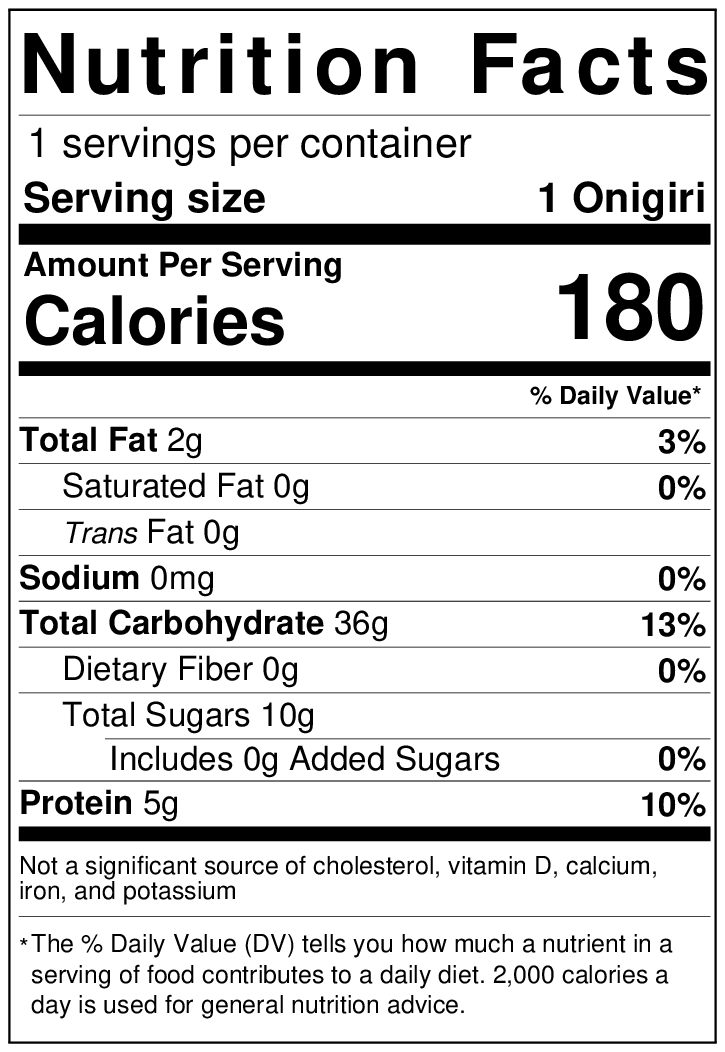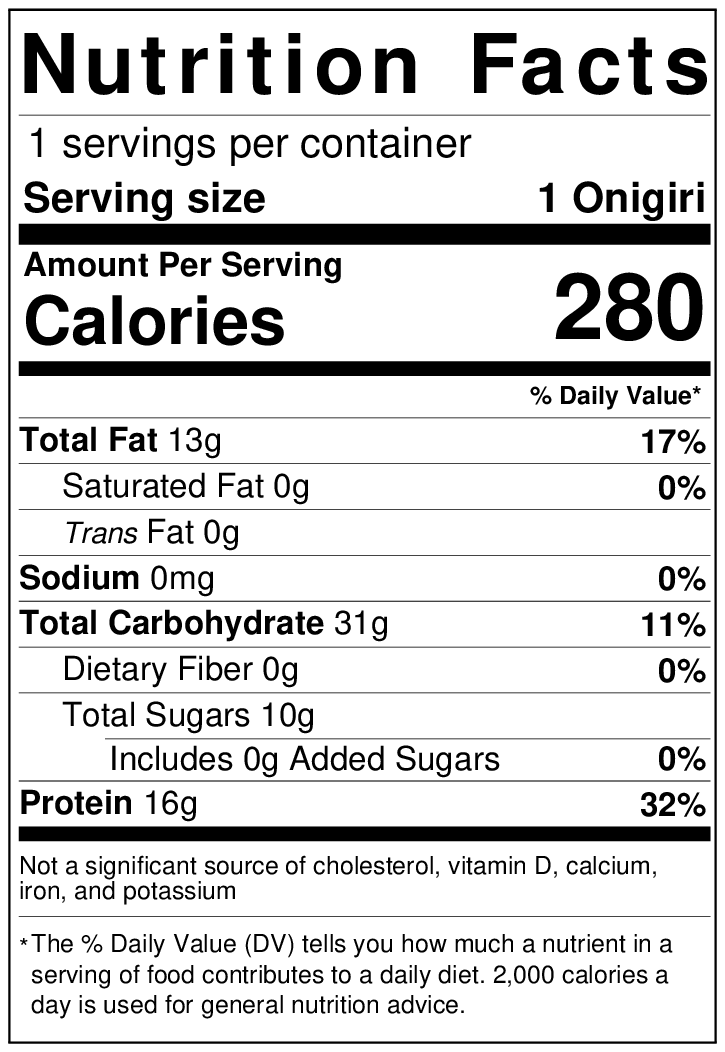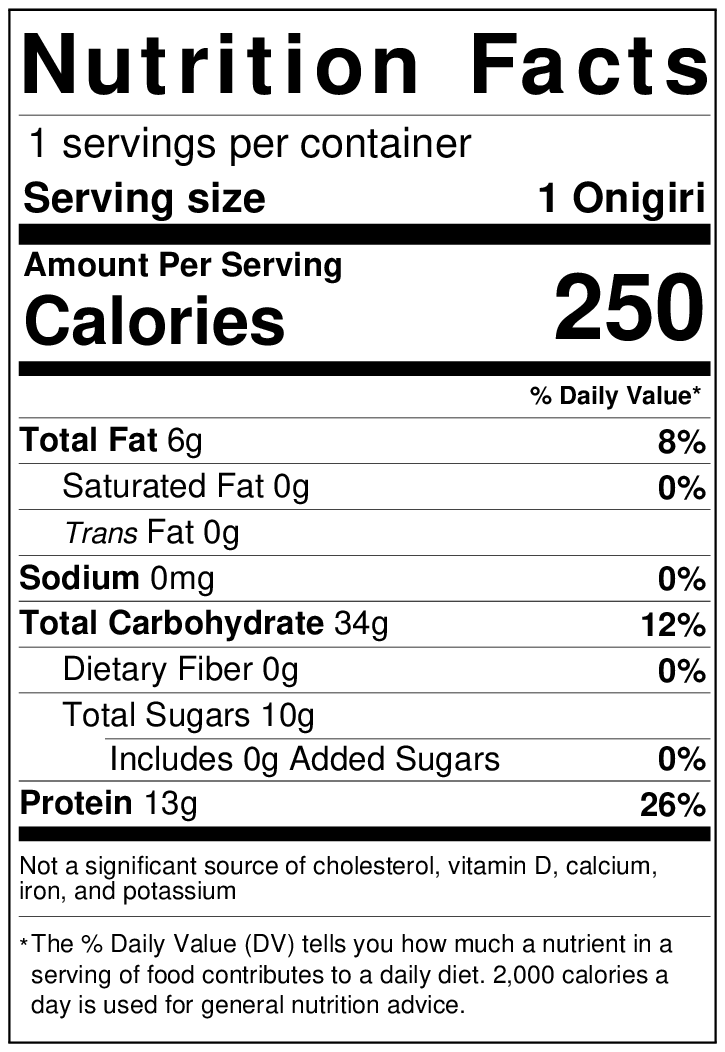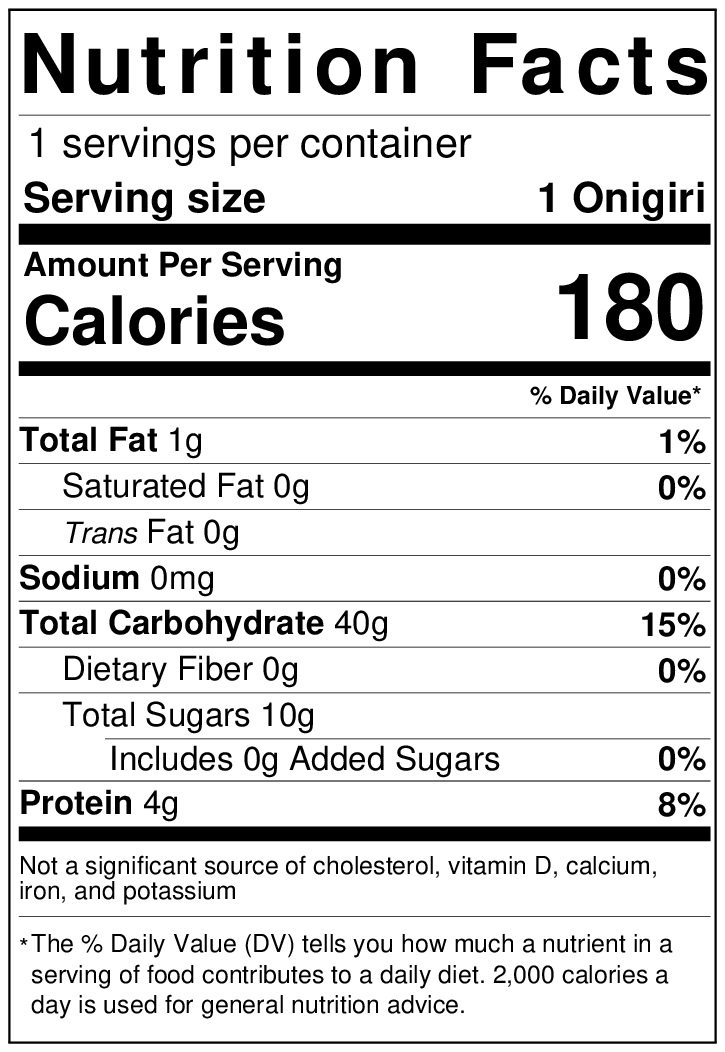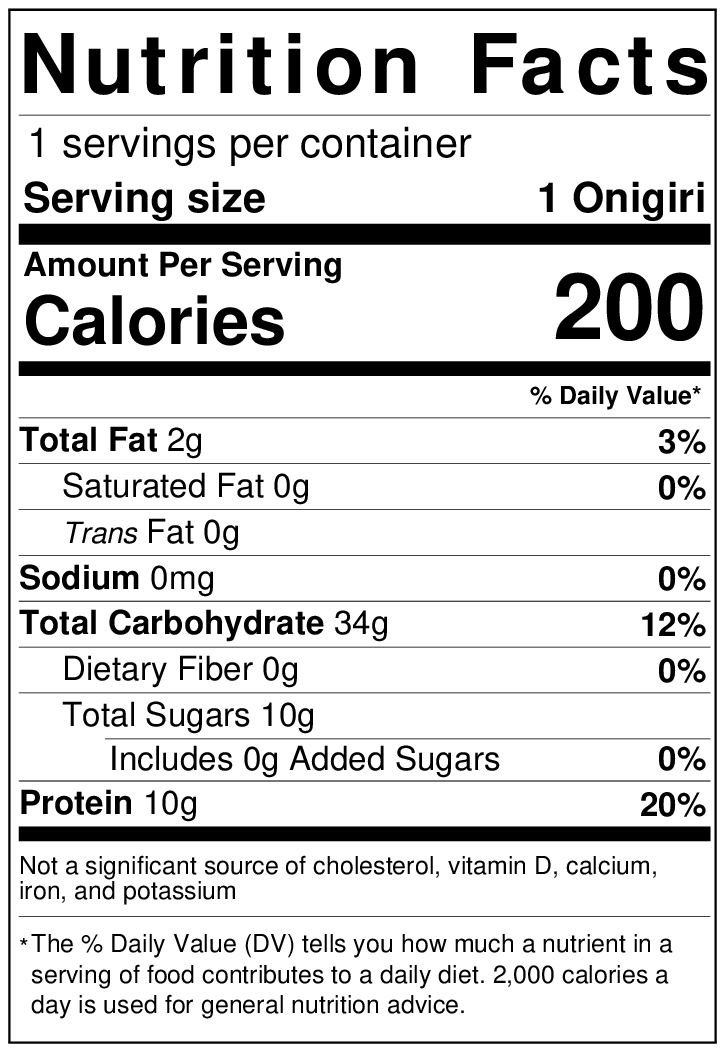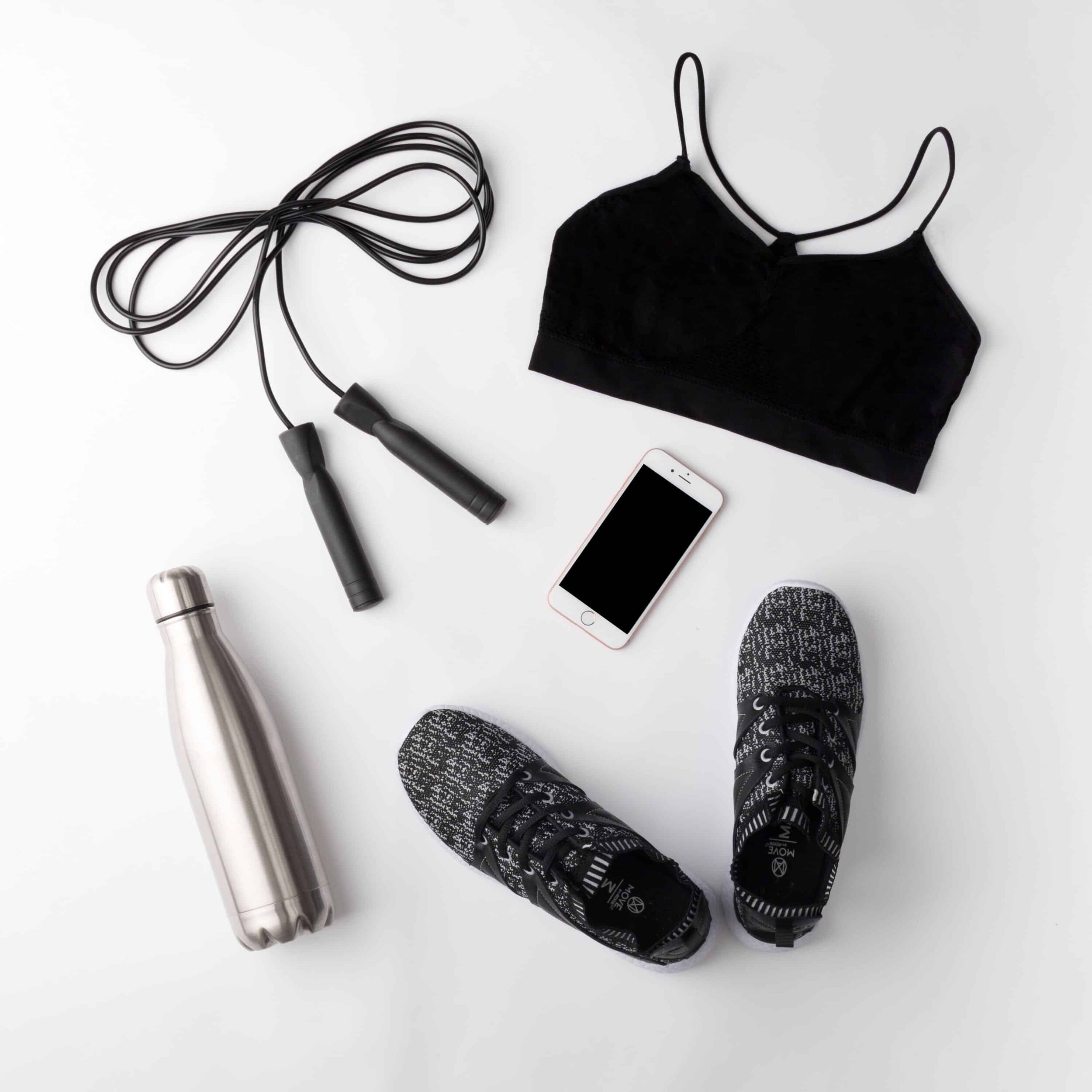Is Onigiri Healthy? (5 Tips for Weight Loss)
Whether you’ve watched Food Wars or any typical Japanese anime, you are bound to see the characters biting into one of the delicious triangle rice balls.
Onigiri is one of the most diverse Japanese dishes that has a great deal of options.
With a wide range of shapes, such as triangles, circles, and squares, you can fill up the rice balls with either chicken, pork, tuna, or even plums!
Even though Onigiri is super delicious, you may be wondering, is onigiri good for weight loss?
Since Onigiri is mainly made up of rice, this rice ball is very high in carbohydrates and relatively low in protein which makes this an unideal food to eat regularly when you are trying to stay fit or lose weight.
With additional ingredients like sugar and oil, an Onigiri rice ball is a calorically dense food that should only be eaten occasionally. However, just because Onigiri is not the best diet food, this does not mean you can not eat Onigiri when you are trying to lose weight!
In this article, we will be discussing 5 easy tips that will help you understand how to incorporate onigiri into your diet while still losing weight!
Know the Ingredients in Onigiri
Understand How Many Calories Are in an Onigiri
Understand Which Onigiri is Worst and Best for Weight Loss
How To Make Your Own Healthy Onigiri
Make Sure To Increase Your Activity Level When Eating Onigiri
Let’s get started!
Tip 1: Know the Ingredients in Onigiri
Onigiri is one of the simplest foods to make because it requires very few ingredients and has a fun and easy assembling process.
The foods we will be discussing are the essential ingredients needed to make an Onigiri and Onigiri.
Rice
This is one of the main ingredients of the Onigiri and is also the main reason why Onigiri is not the ideal food for weight loss.
Since rice is mainly composed of simple carbohydrates, this means that this will add a lot of additional calories to your meal without making you as full if you eat something else.
For every cup of cooked rice, there is around 200 calories and 45 grams of carbohydrates.
This is around just a handful of rice and can add a lot of extra calories into your daily intake.
When you are trying to lose weight, make sure you’re not over consuming on rice and to properly portion size.
Seaweed
From sushi to any Japanese soup, seaweed is a commonly used ingredient in several Japanese dishes.
Often used for its flavorful properties, it is an essential component to give your onigiri that crisp exterior texture.
Seaweed is another low-calorie ingredient that is very low on carbohydrates and fat and is a great source of protein.
Filled with antioxidants and fiber, seaweed is often added as a pairing with Asian dishes to give it a little extra flavor and crunch.
Sugar
The sugar and vinegar that is mixed with the rice is what gives the rice that sweet and savory flavor giving the onigiri ball that unique and addicting taste.
Sugar is another form of simple carbohydrate that we want to make sure to regulate when we are trying to lose weight.
Not only does consuming a lot of sugar add a lot of additional calories to your meals, but sugar often makes you more hungry and craving other sweet foods after a meal.
Try limiting your daily sugar intake to help reduce the amount of calories you consume throughout the day and also to maintain a healthy and balanced diet.
Filling
Finally, we get to the interesting part of the Onigiri.
Onigiris have a wide variety of different fillings with salmon and tuna being some of the most popular dried plums which are a favorite among vegetarians.
In Tip 3, we will be discussing the different types of Onigiris and which fillings are best to incorporate when you are trying to lose weight.
Tip 2: Understand How Many Calories Are in an Onigiri
Now that you have a good idea of the different types of ingredients that go into an Onigiri, let us discuss the nutritional information behind Onigiri.
Understand macronutrients and calories are essential to lose weight and reach your dream physique.
In this section, we will discuss the nutrition behind Onigiri and explain the importance of a calorie deficit.
A typical Onigiri with no filling has around 180 calories with 2 grams of fat, 36 grams of carbohydrates, and 5 grams of protein.
(0 grams of fiber and 10 grams of sugar) Although one Onigiri is not very high in calories, we can see that Onigiri is mainly made up of carbohydrates and contains very little protein.
The reason why we want to eat foods higher in protein is because protein is the essential macronutrient needed to build and maintain muscle.
The more muscle that you have on your body frame, the more calories that you burn during rest. In other words, you burn more calories throughout the day by simply not doing anything!
On top of incorporating more protein into your regular diet, it is also important to make sure you remain in a calorie deficit.
The only way to lose weight is to burn more calories than your Total Daily Energy Expenditure, or TDEE.
You may now be wondering, how do you figure out your TDEE?
This is actually very simple! All you have to do is go onto any credible fitness website, like Bodybuilding.com or NASM, and find their calorie calculator.
By putting in your sex, height, weight, and activity level, this calculator can help you generate an approximate number that is your TDEE.
Once you know your TDEE, to be in a calorie deficit, aim to eat around 300-500 calories less than your TDEE every single day.
Although you may not see results in the first couple of days, or maybe even the first week, it’s important to trust the process and to stay consistent.
Weigh yourself every single day, at the same exact time to get the most accurate results.
My favorite way to track how many calories I am eating every day is by using MyFitnessPal, which allows you to easily input your food into a journal and help you calculate how many calories you are eating throughout the day.
Remember that everyone’s body is unique and the TDEE calculator is simply an estimate.
If you still do not see any results within around two weeks, try lowering your calorie intake by around 100-200 calories and observe the results.
Drink plenty of water throughout the process, and fill your diet with low-calorie options and high protein foods!
Tip 3: Understand Which Onigiri is Worst and Best for Weight Loss
In this section, we will be covering five of the most popular Onigiris and how different fillings can drastically change the macronutrients and calories for an Onigiri.
Starting from the worst Onigiri to the best, you will be able to decide which Onigiri to eat when you are trying to lose weight!
5. Tuna Mayo Onigiri
Taking first place for the worst Onigiri for weight loss is Tuna Mayo Onigiri.
Made with canned tuna and mayonnaise, Tuna Mayo Onigiri is a delicious and flavorful rice ball that has a perfect sweet and salty balance.
For every Tuna Mayo Onigiri, there is a total of 280 calories with 13 grams of fat, 31 grams of carbohydrates, and 16 grams of protein.
As you can see, Tuna Mayo Onigiri has a good amount of protein, but also a lot of extra fat and carbohydrates, making this not the best option.
Since mayonnaise is completely composed of fat, this adds a lot of extra calories to your Onigiri.
If you take out the mayonnaise from the onigiri, this actually turns out to be a much lower calorie rice ball!
4. Nikumaki - sliced pork
Nikumaki Onigiri is probably the most unique looking Onigiri out of the five.
Rather than having a filling, Nikumaki is wrapped with thinly sliced pork that neatly wraps around the rice.
For every Nikumaki, there is a total of 250 calories with 6 grams of fat, 34 grams of carbohydrates, and 13 grams of protein.
Lower in fat compared to the Tuna Mayo Onigiri, Nikumaki is a better lower-calorie option.
Nikumaki is actually not a terrible option to eat if you are really craving an Onigiri ball.
Just know that if you end up eating more than one, this Nikumaki ball can easily become a 500 calorie meal and add an additional 70 grams of carbohydrates to your daily intake.
3. Umeboshi Onigiri (ume okaka) - plum onigiri
Umeboshi Onigiri is a delicious rice ball that is filled with dried pink plums, that add a lot of salty and sourness to your onigiri ball.
This unique onigiri flavor is very popular in Japan and has also become a favorite among the general people.
For every Umeboshi Onigiri, there is a total of 180 calories with 1 gram of fat, 40 grams of carbohydrates, and 4 grams of protein.
This is the lowest calorie onigiri, which is a good thing to have but is also very low in protein.
If you have eaten a lot of protein-dense foods throughout the day, and Umeboshi Onigiri may be a great snack to have if you are really craving a rice ball.
Keep in mind that one Umeboshi has 40 grams of carbohydrates, so this may mean eliminating a carbohydrate source in one of your main meals.
2. Salmon Onigiri
Salmon Onigiri, along with Tuna Mayo Onigiri, is one of the most popular onigiri options.
Filled with dried salmon flakes, Salmon Onigiri is a delicious onigiri that is a perfect balance of sweet and salty.
For every Salmon Onigiri, there are around 200 calories with 2 grams of fat, 34 grams of carbohydrates, and 10 grams of protein.
Very low in fat and relatively higher in protein, Salmon Onigiri is a better lower calorie option compared to the other onigiris.
1. Chicken Onigiri
Taking first place for the best Onigiri option would have to be the Chicken Onigiri.
Made up of chicken thighs, Chicken Onigiri is a delicious and fulfilling Onigiri option that is high in protein and a more savory Onigiri.
For every Chicken Onigiri, there are around 230 calories with 5 grams of fat, 31 grams of carbohydrates, and 14 grams of protein.
Made up with less fat and more protein, Chicken Onigiri is one of the better options that are higher in protein and lower in fat.
Leaning as one of the Onigiris that is slightly lower in carbohydrates, this is probably the best option to choose when you are trying to lose weight.
Tip 4: How to Make Your Own Healthy Onigiri
Although we covered all the popular onigiris and which ones are the best option for weight loss, many of these recipes are still not super healthy meals that will keep you full and energized throughout the day.
The good news is that we have a couple of tips that will help you make your own onigiri that uses more ideal ingredients and will help increase the amount of protein in your meal!
Add More Filling
The reason why we want to add more filling is because the more filling you use in your Onigiri ball, the less rice you use which reduces the overall amount of carbohydrates.
Most of the fillings are some source of protein, so having more protein from seafood or meats, will make you feel more satiated.
Use a Lean Source of Protein As your Filling
As stated above, add more filling, but also add the right filling.
When choosing a filling, try using lean sources of protein like canned tuna, chicken breast, or a lean source of beef.
Lean sources of protein are much lower in fat and can drastically reduce the amount of fat in your onigiri.
Pair with Vegetables
Finally, since onigiris are low in fiber, it is important to pair your onigiri with some low-calorie vegetables to add some volume to your meal.
Vegetables are one of the best foods to keep you full, add some additional protein, and are also super low in calories.
Some of my favorite vegetables are broccoli, boc choy, green beans, and cabbage.
If you are having trouble thinking of a healthy onigiri recipe,
Aspire Fitness has a Youtube channel that teaches you how to make your favorite Asian dishes in a healthier and just as delicious way!
The Healthy Aspire Onigiri Recipe has two easy onigiri options that are way lower in calories and carbohydrates and are high protein dishes.
The reason why these two options are lower in carbohydrates is because we decided to replace regular sugar with Monk Fruit sweetener, which is a zero-calorie and zero-carbohydrate sugar that adds the same exact sweetness to your onigiri.
On top of that, we followed the tips listed above by packing our rice balls with filling and choosing lean sources of protein.
Teriyaki Chicken Onigiri
The Teriyaki Chicken Onigiri uses thinly sliced chicken breast marinated in teriyaki sauce for extra flavor.
For every Healthy Teriyaki Chicken Onigiri, there are around 160 calories with 7 grams of fat, 15 grams of carbohydrates, and 11 grams of protein.
Kimchi Tuna Onigiri
Kimchi Tuna Onigiri is Aspire Fitness’ own unique take on a healthy filling. Kimchi is a great fermented vegetable that gives your rice ball a super delicious flavor for very little calories.
For every Healthy Kimchi Tuna Onigiri, there are around 170 calories with 9 grams of fat, 17 grams of carbohydrates, and 8 grams of protein.
Tip 5: Make Sure To Increase Your Activity Level when Eating Onigiri
Remember, although nutrition is a huge factor that influences weight loss, it is important to pair this journey with exercise as well. Especially strength training.
Several years of research on the benefits of weight training have shown that individuals that do some sort of consistent resistance training at least 3-5 times a week have shown not only a great amount of weight loss but are also able to keep the weight off!
The secret to this phenomena is that strength training leads to a build-up of muscle.
Not only does your body recomposition into a more fitting and athletic-looking aesthetic, but having more muscle also increases your resting metabolic rate which essentially means you burn more calories at rest!
Now that we know the importance of muscle we need to make sure we stay on track with our workouts.
Consistency and longevity are the two key factors when building muscle so there will be some commitment involved.
We understand that not everyone has access to a gym membership or feels comfortable starting off in such an intimidating environment.
Although I would strongly recommend that everyone should get a gym membership, don’t worry we got your back!
You can either go to the gym or build one for yourself.
It really just comes down to 3 pieces of equipment that you need to do most workouts.
These three are the workout bench, dumbbells, and gym flooring.
Check out our recommended gear page to see our best picks for these pieces of equipment here.
https://www.aspirefitnesswalnut.com/home-workout-equipment
If a home gym is not for you then getting a membership somewhere works too.
As long as you are starting your muscle-building journey, we’re happy!
CONCLUSION
So there you have it! Now that you know the ingredients and nutritional information of an Onigiri, how to choose the best
Onigiri, and how to make your own healthy version of this rice ball, you are on track to reaching your goals!
Don’t forget the importance of consistently exercising or doing some form of strength training to keep your body active and strong.
Dieting doesn’t have to be a painful and tedious process that means cutting out all of your favorite foods.
Remember it’s all about portion sizing, patience, and consistency!
The Asian Weight Loss Cookbook
The 15 Fat Burning Meals Cookbook features our favorite recipes that you can use to get closer to your fitness goals.
Become your own personal trainer with the guidance of this book and make this the year you achieve your insurmountable fitness goals.
PHILLIP PAK
Phillip Pak is a fitness expert who has been training clients for 5 years. Throughout his fitness journey, Phill has done it all when it comes to diet and nutrition. He is now the owner of Aspire Fitness Walnut where his main goal is to help those who are seeking to find the best version of themselves. He’s been through the struggle of obtaining an good physique and knows how to share it with others.




